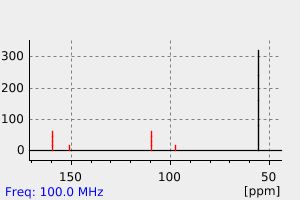dimethyl 2,2-dicyanoethene-1,1-dicarboxylate | 82849-49-8
中文名称
——
中文别名
——
英文名称
dimethyl 2,2-dicyanoethene-1,1-dicarboxylate
英文别名
dimethyl (dicyanomethylidene)propanedioathe;2,2-dicyano-ethene-1,1-dicarboxylic acid dimethyl ester;Propanedioic acid, (dicyanomethylene)-, dimethyl ester;dimethyl 2-(dicyanomethylidene)propanedioate
CAS
82849-49-8
化学式
C8H6N2O4
mdl
——
分子量
194.147
InChiKey
MOMVYIYOIUVKEW-UHFFFAOYSA-N
BEILSTEIN
——
EINECS
——
-
物化性质
-
计算性质
-
ADMET
-
安全信息
-
SDS
-
制备方法与用途
-
上下游信息
-
文献信息
-
表征谱图
-
同类化合物
-
相关功能分类
-
相关结构分类
物化性质
-
沸点:258.7±40.0 °C(Predicted)
-
密度:1.315±0.06 g/cm3(Predicted)
计算性质
-
辛醇/水分配系数(LogP):0.1
-
重原子数:14
-
可旋转键数:4
-
环数:0.0
-
sp3杂化的碳原子比例:0.25
-
拓扑面积:100
-
氢给体数:0
-
氢受体数:6
反应信息
-
作为反应物:参考文献:名称:Zwitterionic tetramethylenes as the common intermediates in the cycloaddition and polymerization reactions of N-vinylcarbazole with electrophilic tetrasubstituted ethylenes: a new explanation for charge-transfer initiation摘要:DOI:10.1021/ja00276a037
-
作为产物:参考文献:名称:Dimethyl 1,1-dicyanoethene-2,2-dicarboxylate, a new electrophilic olefin摘要:DOI:10.1021/jo00144a033
文献信息
-
The mechanism of [2 + 1] and [2 + 2] cycloaddition reactions of 1-phenylseleno-2-(trimethylsilyl)ethene: an isotopic labelling study †作者:Shoko Yamazaki、Yuichiro Yanase、Kagetoshi YamamotoDOI:10.1039/a909919k日期:——The reactions of deuterio-labelled 1-seleno-2-silylethenes with trimethyl 2-phosphonoacrylate 2 and methyl vinyl ketone 4 in the presence of SnCl4 gave deuterio-substituted cyclopropanes with 1,2-silicon migration. The reaction of deuterio-labelled 1-seleno-2-silylethenes with dimethyl 2,2-dicyanoethene-1,1-dicarboxylate 6 in the presence of SnCl4 and ZnBr2 gave deuterium-substituted cyclobutanes without silicon migration. This labelling study strongly confirms the 1,2-silicon migration for [2 + 1] cycloadditions of 1 and non-1,2-silicon migration for the [2 + 2] cycloaddition reactions, respectively.
-
Cycloadditions of Bifunctional Vinyl Ethers with Electrophilic Alkenes through Tetramethylene Zwitterion Intermediates作者:Eric J. May、Anne Buyle Padias、Robert B. Bates、Henry K. HallDOI:10.1002/hlca.200590112日期:2005.6Bifunctional vinyl ethers react with electron-poor alkenes to cyclobutanes in good yields. The second CC bond reacted with neither the cyclobutane nor its zwitterion intermediate, even on heating. Cyclobutanes formed from ‘tetracyanoethylene’ (8) were transformed into tetrahydropyridines by reaction of the corresponding zwitterion with MeCN as the solvent. In contrast, cyclobutanes formed from dimethyl
-
a(<i>E</i>)-1-Methoxy-1,3-butadiene and 1,1-Dimethoxy-1,3-butadiene in (4 + 2) Cycloadditions. A Mechanistic Comparison作者:Reiner Sustmann、Surajin Tappanchai、Heinz BandmannDOI:10.1021/ja961390l日期:1996.1.1The reactions of (E)-1-methoxy-1,3-butadiene (1) and 1,1-dimethoxy-1,3-butadiene (2) with a series of dienophiles of increasing electrophilicity are described Stereochemical studies reveal that the cycloadditions of 1 are concerted processes, even for the most electron-deficient olefins dimethyl dicyanofumarate and dimethyl dicyanomaleate. 1,1-Dimethoxy-1,3-butadiene reacts under our conditions (dilute solutions and temperatures less than or equal to 60 degrees C) only with those dienophiles which can give zwitterions out of the antiperiplanar conformation of the diene. Zwitterionic intermediates can be trapped by methanol. In the case of tetracyanoethene the kinetics of decay of an intermediate, interpreted as the zwitterion, can be followed by stopped flow techniques: E(a) = 14.8 +/- 0.2 kcal mol(-1), log A = 11.9 +/- 0.1, Delta H double dagger = 10.8 +/- 0.1 kcal mol(-1), Delta S double dagger = -6.2 +/- 0.1 cal mol(-1) K-1, and Delta G double dagger = 11.40 +/- 0.03 kcal mol(-1).
-
Sustmann, Reiner; Siangouri-Feulner, Ioana, Chemische Berichte, 1993, vol. 126, # 5, p. 1241 - 1246作者:Sustmann, Reiner、Siangouri-Feulner, IoanaDOI:——日期:——
-
Rese, Michael; Dern, Mechthild; Luecking, Karin, Liebigs Annalen, 1995, # 7, p. 1139 - 1152作者:Rese, Michael、Dern, Mechthild、Luecking, Karin、Sustmann, ReinerDOI:——日期:——
表征谱图
-
氢谱1HNMR
-
质谱MS
-
碳谱13CNMR
-
红外IR
-
拉曼Raman
-
峰位数据
-
峰位匹配
-
表征信息
同类化合物
(±)17,18-二HETE
(±)-辛酰肉碱氯化物
(Z)-5-辛烯甲酯
(Z)-4-辛烯酸
(R)-甲羟戊酸锂盐
(R)-普鲁前列素,游离酸
(R,R)-半乳糖苷
(E)-4-庚烯酸
(E)-4-壬烯酸
(E)-4-十一烯酸
(9Z,12E)-十八烷二烯酸甲酯
(6E)-8-甲基--6-壬烯酸甲基酯-d3
(3R,6S)-rel-8-[2-(3-呋喃基)-1,3-二氧戊环-2-基]-3-羟基-2,6-二甲基-4-辛酮
龙胆二糖
黑曲霉二糖
黄质霉素
麦芽酮糖一水合物
麦芽糖醇
麦芽糖酸
麦芽糖基蔗糖
麦芽糖一水合物
麦芽糖
鳄梨油酸乙酯
鲸蜡醇蓖麻油酸酯
鲸蜡醇油酸酯
鲸蜡硬脂醇硬脂酸酯
鲸蜡烯酸脂
鲸蜡基花生醇
鲫鱼酸
鲁比前列素
鲁比前列素
高级烷基C16-18-醇
高甲羟戊酸
高效氯氰菊酯
高-gamma-亚油酸
马来酸烯丙酯
马来酸氢异丙酯
马来酸氢异丁酯
马来酸氢丙酯
马来酸氢1-[2-(2-羟基乙氧基)乙基]酯
马来酸单乙酯
马来酸单丁酯
马来酸二辛酯
马来酸二癸酯
马来酸二甲酯
马来酸二烯丙酯
马来酸二正丙酯
马来酸二戊基酯
马来酸二异壬酯
马来酸二异丙酯







